Physical Address
304 North Cardinal St.
Dorchester Center, MA 02124
Physical Address
304 North Cardinal St.
Dorchester Center, MA 02124
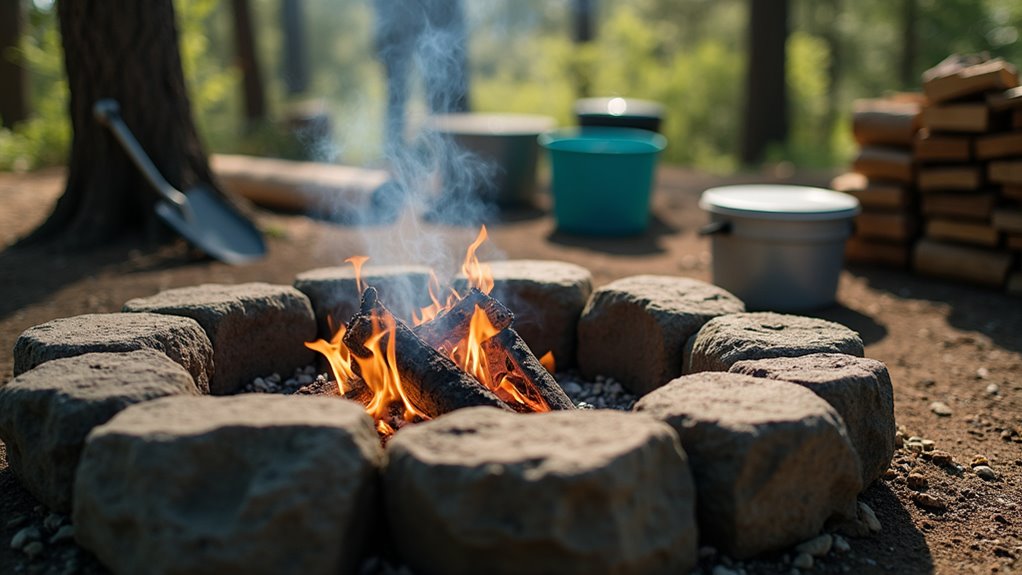
Uncover the 12 essential campfire safety tips that could save your life and prevent wilderness disasters on your next outdoor adventure.
You’ve probably gathered around countless campfires, watching flames dance against the night sky while sharing stories with friends. But here’s the thing – that perfect evening can turn dangerous faster than you’d expect if you’re not prepared. Whether you’re a seasoned camper or planning your first outdoor adventure, there are essential safety measures you can’t afford to overlook. Let’s explore how you can protect yourself, others, and the wilderness while still enjoying every moment.

Before you strike that first match, you’ll want to check if campfires are even allowed in your area. Fire restrictions change frequently based on drought conditions, wind patterns, and seasonal risks. Contact local ranger stations, park offices, or check official websites for current fire bans and permits required.
Always verify current fire restrictions with local authorities before lighting any campfire, as regulations change based on environmental conditions.
Weather plays a pivotal role too. Don’t build fires during high winds, extremely dry conditions, or when storms are approaching. Wind can scatter embers up to a mile away, starting wildfires in minutes.
Check the fire danger rating for your location – it’s usually posted at park entrances or available online.
Even if fires are permitted, use common sense. If conditions feel risky, skip the campfire and enjoy other camping activities instead.
Following proper campfire safety guidelines will help ensure your camping experience remains both memorable and safe for everyone involved.
Once you’ve confirmed fires are allowed and conditions are safe, your next step is finding the right spot to build your campfire.
Look for an open area that’s at least ten feet away from tents, trees, bushes, and dry grass. Rocky or sandy ground works best since it won’t catch fire easily.
Clear away any leaves, twigs, or other flammable debris from a ten-foot radius around your chosen spot. If there’s an existing fire ring, use it – but still check the surrounding area for hazards.
Avoid windy locations where sparks could blow toward vegetation or your gear.
Stay away from overhanging branches, even if they seem high up. Heat rises, and you don’t want to accidentally ignite anything above your fire.
Remember that camp fire safety requires constant vigilance from the moment you start building until your fire is completely extinguished.

After selecting your campfire location, you’ll need to contain the flames within a proper fire ring or designated fire pit. If you’re at an established campground, use existing fire rings whenever possible—they’re designed for safety and efficiency.
When creating your own fire ring, dig a shallow pit about one foot deep and surround it with rocks. Choose non-porous stones like granite, avoiding river rocks that can explode when heated. Make your ring at least three feet wide to contain sparks and embers effectively.
Clear all vegetation, leaves, and debris within a ten-foot radius around your fire ring. Keep the area completely bare down to mineral soil. This containment system prevents flames from spreading beyond your controlled space, giving you peace of mind while enjoying your campfire.
Taking time to properly construct your fire ring helps you avoid common mistakes that can lead to dangerous situations or uncontrolled fires.
While establishing your fire ring creates the foundation for safe campfire containment, you must also eliminate all flammable materials from the surrounding area. Clear a circle extending at least 10 feet in all directions from your fire pit.
Remove dry leaves, pine needles, twigs, grass, and any loose bark or wood debris. Don’t forget to look up—trim or avoid low-hanging branches that could catch sparks.
Pay special attention to areas where wind might blow embers, extending your clearing zone if necessary. Even small pieces of debris can ignite quickly and spread flames beyond your control.
This preparation step takes just minutes but prevents potential disasters. You’re creating a safety barrier that protects both your campsite and the surrounding wilderness.
These safety practices become especially important during caravan camping adventures where multiple families may be setting up fires in close proximity to each other.
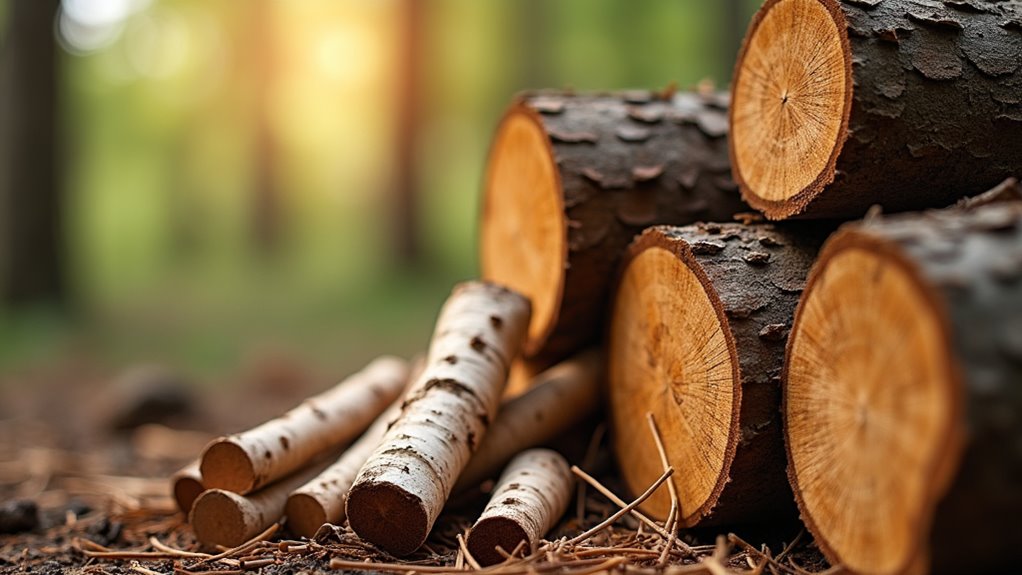
Now that you’ve prepared your fire area, it’s time to collect the proper fuel to keep your campfire burning safely and efficiently. You’ll need three types of wood: tinder, kindling, and fuel wood.
Gather dry tinder like birch bark, dry grass, or small twigs that’ll catch fire easily. For kindling, collect pencil-thick to thumb-thick dry sticks that’ll help your fire grow. Your fuel wood should be wrist-thick to forearm-thick pieces of seasoned hardwood.
Collect tinder, kindling, and fuel wood in progressively thicker sizes—from grass-thin to forearm-thick—using only dry, dead materials for optimal burning.
Always use dead, dry wood that snaps cleanly when broken. Avoid green or wet wood, which creates excessive smoke and burns poorly. Don’t strip bark from living trees or break branches from healthy vegetation.
Collect more wood than you think you’ll need—running out mid-fire isn’t ideal. Just as you’d prepare essential gear like ensuring your tent is waterproofed before a camping trip, having adequate firewood ready prevents interruptions to your campfire experience.
With your wood collection complete, you’ll want to set up your safety equipment before striking that first match. Having fire suppression tools within arm’s reach isn’t just smart—it’s essential for responsible camping.
Position these three critical items near your fire pit:
Don’t wait until flames get out of control to think about suppression. You’ll feel more confident enjoying your campfire knowing you’re prepared for any situation. After extinguishing your fire completely, you can look forward to restful nights in your comfortable camping hammock.
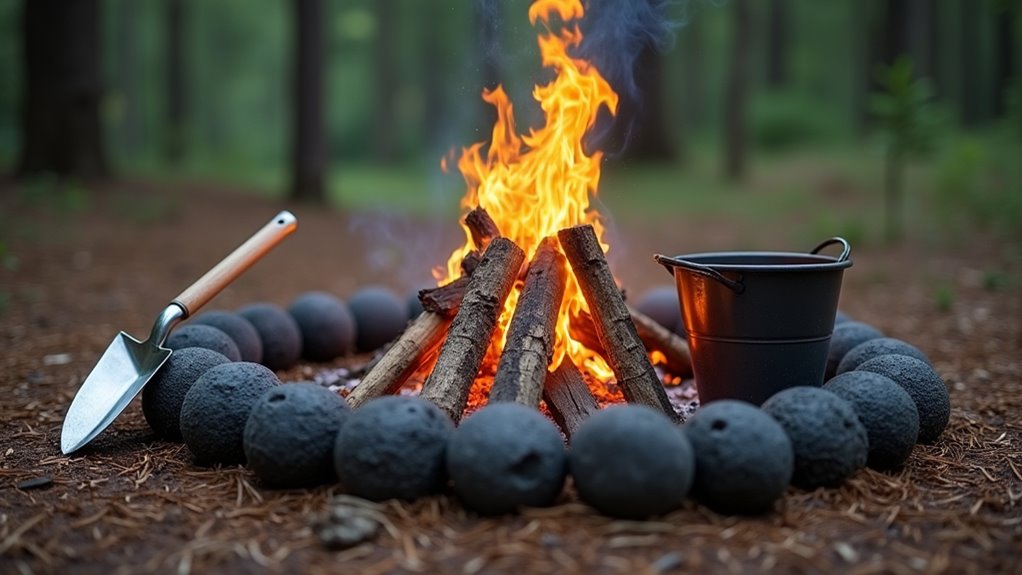
Once you’ve gathered your safety tools, it’s time to build a fire that stays manageable from start to finish. Start small with tinder, kindling, and gradually add larger wood. Don’t dump all your fuel at once – you’ll create an uncontrollable blaze that’s dangerous and wasteful.
Keep your fire contained within the designated fire ring or pit. Never let flames grow taller than knee-high, and maintain a clear perimeter of at least ten feet around your fire. Remove any overhanging branches or flammable debris from this area.
Stay with your fire at all times. Wind can shift quickly, sending sparks flying or changing flame direction. If conditions become too windy or dry, extinguish your fire immediately. You’re responsible for every spark your campfire produces.
These safety practices become even more crucial during summer camp adventures when young campers are learning outdoor skills and creating lasting memories around the campfire.
While it might seem obvious, leaving your campfire unattended ranks among the most dangerous mistakes campers make. Even well-built fires can spread quickly when wind picks up or sparks fly to nearby vegetation. You’re responsible for your fire from the moment you light it until it’s completely extinguished.
Here’s what happens when you leave your fire unattended:
Stay within sight of your fire at all times. If you must leave, designate another responsible adult to watch it. If you’re planning hiking activities during your camping trip, make sure to completely extinguish your fire before heading out on the trails.
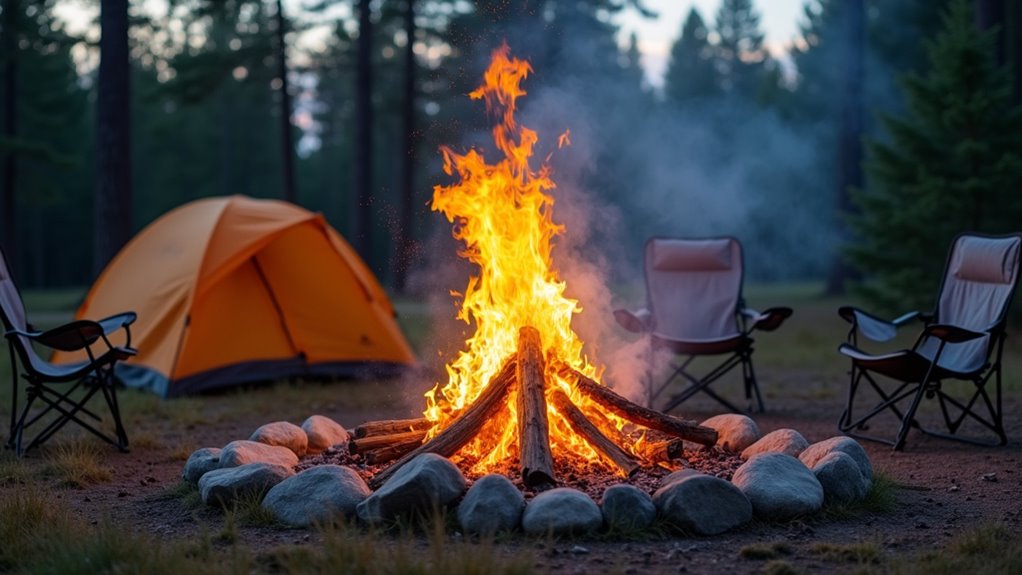
Wind can transform a controlled campfire into a dangerous wildfire in minutes, making it essential that you constantly assess conditions throughout your camping trip. Check wind speed and direction before lighting your fire and monitor changes regularly. If winds exceed 10-15 mph, don’t start a fire at all.
Position your fire pit away from overhanging branches and downwind from your tent or shelter. Create a windbreak using rocks or logs if needed, but ensure proper airflow for combustion.
When winds pick up unexpectedly, reduce your fire’s size immediately or extinguish it completely.
Watch for flying embers that strong gusts can carry far from your campsite. You’re responsible for preventing these sparks from igniting nearby vegetation. Stay alert and prioritize safety over ambiance.
Wind safety becomes even more critical when camping with toddlers, as young children may not understand the increased dangers that gusty conditions create around campfires.
Before you leave your campsite or turn in for the night, you must completely extinguish your fire using a systematic approach that combines water and soil.
Start by allowing the wood to burn down to ash whenever possible.
Then pour water slowly over the entire fire area, including all embers and ashes. You’ll hear hissing and steaming—that’s normal and expected.
Follow this three-step process to ensure complete extinguishment:
Never leave until you’re absolutely certain there’s no heat remaining. A properly extinguished fire protects everyone.
Having the right camping essentials like proper fire extinguishing tools makes this safety process much more manageable and effective.
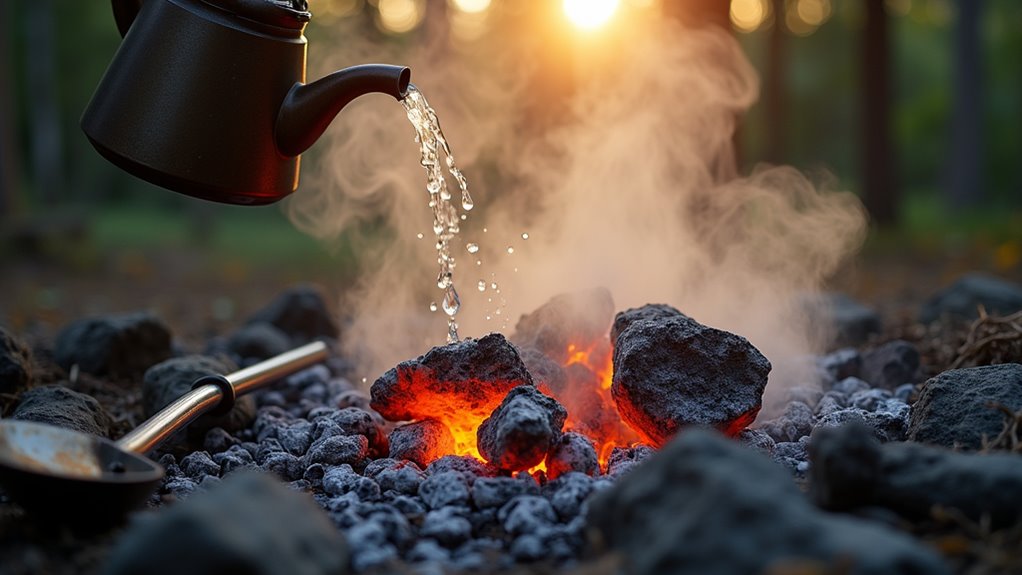
Even after following proper extinguishing steps, you can’t assume your fire is completely out until you’ve performed a final verification check.
Hold your hand several inches above the ashes to feel for any heat. If you detect warmth, add more water and stir again.
Look for glowing embers, smoke, or steam rising from the fire pit. Listen carefully for crackling or hissing sounds that indicate hidden hot spots.
Don’t rush this process – it’s worth taking extra time to ensure safety.
Walk around the entire fire area and check for scattered embers that might’ve rolled away from the main pit.
Only leave once you’re absolutely certain there’s no heat, smoke, or glowing materials remaining.
Your diligence prevents wildfires and protects nature.
For jungle camping adventures, consider using a hammock setup instead of ground camping to minimize fire risks and reduce your environmental impact.
Once you’ve confirmed your fire is completely extinguished, it’s time to restore the site to its natural state. Following Leave No Trace principles guarantees future campers can enjoy pristine wilderness areas.
Here’s how you’ll properly restore your fire site:
You’re not just cleaning up—you’re conserving nature’s beauty for others. When done correctly, no one should detect where your fire burned.
This responsible approach protects wildlife habitats and maintains the wilderness experience everyone deserves. Consider combining your camping adventures with bicycle camping to explore more remote areas while maintaining minimal environmental impact.
You’ve got the tools to enjoy campfires responsibly! Remember, wildfires destroy approximately 7 million acres annually in the U.S., with many started by unattended campfires. Don’t become part of that statistic. By following these safety tips—checking restrictions, choosing smart locations, and completely extinguishing your fire—you’re protecting both wilderness areas and fellow outdoor enthusiasts. Your careful preparation means you can relax around the flames, knowing you’re camping safely and sustainably.